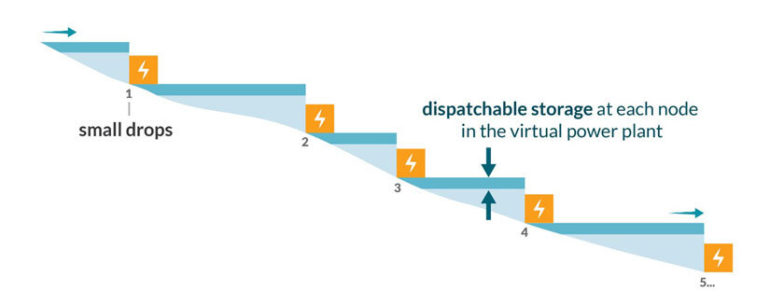A California company, Natel Energy, is hard at work developing a low-head, low-impact hydropower approach that addresses one of the leading concerns of new deployment—impacts to natural stream flows.
Of course, if environmental mitigation strategies take too big a bite out of revenues, the effort is a nonstarter. At the same time, the company is passionate about minimizing environmental impacts and, ideally, contributing to restoring and protecting local ecosystems.
To address this challenge, the National Renewable Energy Laboratory (NREL) helped Natel rethink hydropower. Former NREL Research Engineer Michael Craig and NREL Hydropower Technical Manager Greg Stark worked with Natel CEO Gia Schneider and her colleagues to investigate the revenue and downstream flow trade-offs for a hypothetical series of small, cascading hydropower installations. This system of 36 facilities is designed to preserve river connectivity for water, fish, sediment, and people. NREL’s analysis indicated that the effects on natural stream flows can be negligible if the system is controlled in a coordinated manner.
“NREL moved the needle on both fronts—economic and ecological sustainability—by building a model that helped us quantify and understand the trade-offs between revenue and downstream flow impacts,” Schneider said. “That work showed that the revenue reduction from the operational changes needed to achieve our environmental objectives was small, less than 4%.”
Insights gained from NREL’s analysis also led Natel to consider combining new hydropower projects into larger virtual power plants (VPPs). By leveraging advances in distributed energy resource management, microgrids, and batteries, these hydropower VPPs can deliver grid reliability services with minimal environmental impact and no carbon emissions.
With modern power electronics and controls, the small plant and pond at each node of the cascade can be managed in concert with the other nodes to meet energy demand. This flexibility allows the plant to produce reliable renewable energy with dispatchable energy storage and enables system operators to integrate more-variable and less-flexible renewable energy resources like wind and solar into the grid.
In addition to protecting natural river flows, these installations help reconnect rivers to floodplains, restore habitat and river biodiversity, mitigate flooding, and bolster groundwater recharge.
“Natel provides hardware and software solutions designed to mitigate climate change, build climate resilience, and, eventually, develop a 100% renewable grid,” Schneider said. “The work we did with NREL has enabled us to further advance grid-scale distributed sustainable hydropower.”
Untapped potential exists for blending hydropower, floating PV
More information:
Michael Craig et al. Net revenue and downstream flow impact trade-offs for a network of small-scale hydropower facilities in California, Environmental Research Communications (2019). DOI: 10.1088/2515-7620/aafd62
Provided by
National Renewable Energy Laboratory
Citation:
Rethinking hydropower for energy and environmental sustainability (2021, April 23)
retrieved 24 April 2021
from https://techxplore.com/news/2021-04-rethinking-hydropower-energy-environmental-sustainability.html
This document is subject to copyright. Apart from any fair dealing for the purpose of private study or research, no
part may be reproduced without the written permission. The content is provided for information purposes only.



